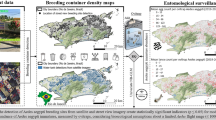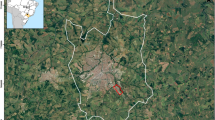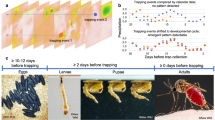Abstract
We studied the dispersion of Aedes aegypti during egg laying in natural conditions. Two independent experiments involving mosquitoes dispersing from urbanization towards adjacent un-urbanized areas were carried out and analyzed in statistical terms. We find relations between stochastic variables related to the egg laying mosquito activity (ELMA), useful to assess dispersion probabilities, despite the lack of knowledge of the total number of ovipositions in the zone. We propose to evaluate the activity as minus the logarithm of the fraction of negative ovitraps at different distances from buildings. We also estimate the average number of eggs laid per oviposition using a regression between the ELMA and the number of eggs found. Three zones with different oviposition activity were determined: a corridor surrounding the urbanized area, a second region between 10m and 25m and the third region extending from 30m to 45m from the urbanization. The landscape (plant cover) and the human activity in the area appear to have an influence in the dispersal of Aedes aegypti.
Similar content being viewed by others
Article PDF
Author information
Authors and Affiliations
Corresponding author
Rights and permissions
About this article
Cite this article
Bergero, P., Ruggerio, C., Lombardo, R. et al. Dispersal of Aedes aegypti: field study in temperate areas and statistical approach. Nat Prec (2012). https://doi.org/10.1038/npre.2012.6960.1
Received:
Accepted:
Published:
DOI: https://doi.org/10.1038/npre.2012.6960.1



